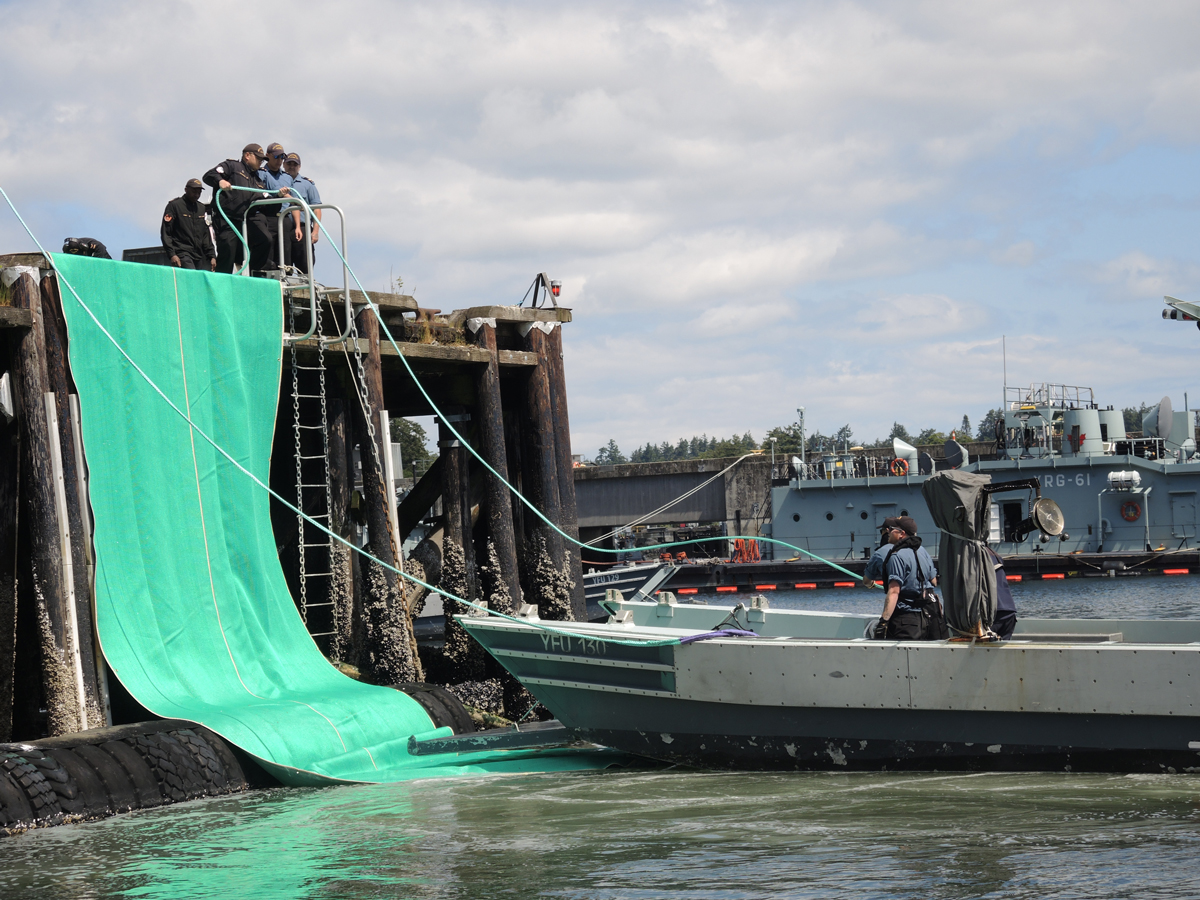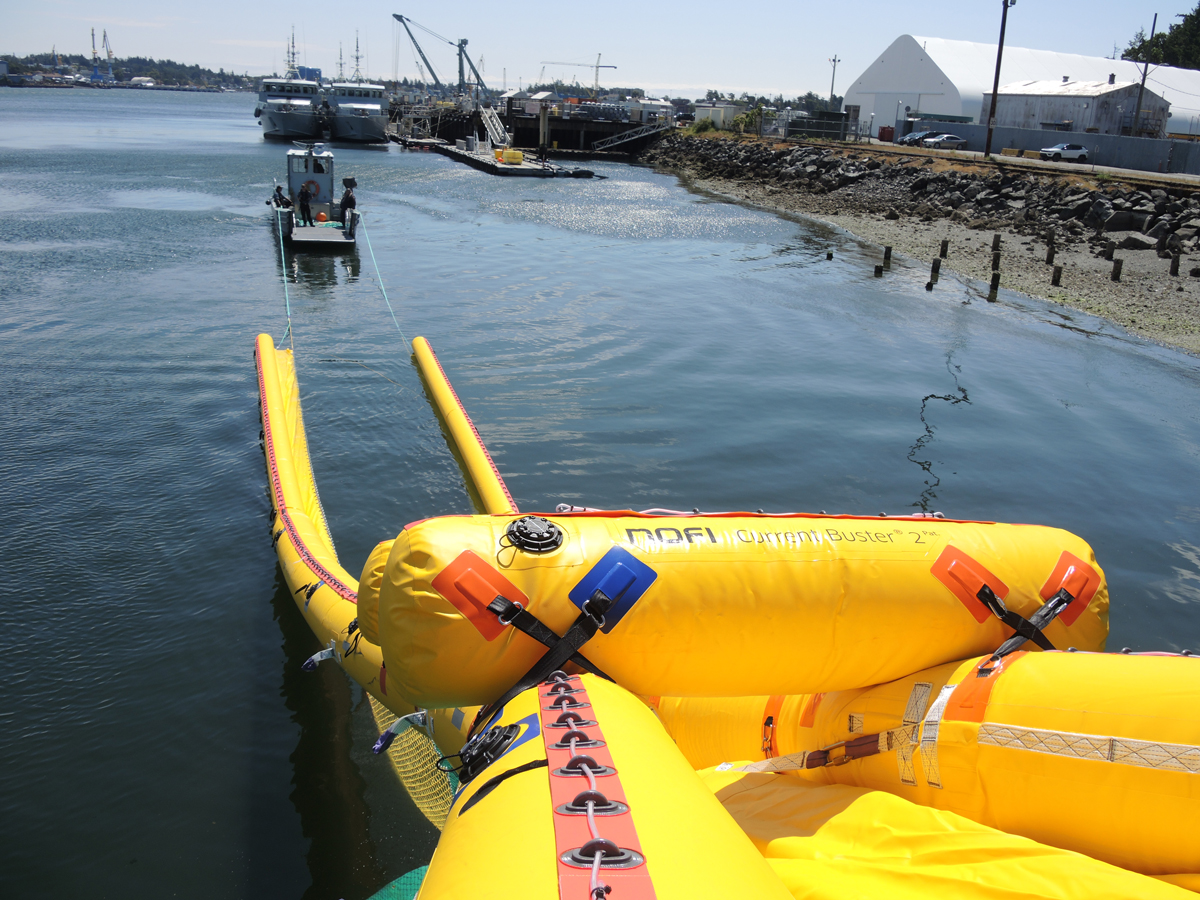PCTU, Auxiliary Fleet test new spill response kit
By Lookout on Jun 20, 2022 with Comments 0

Members of Queens’ Harbour Master and Patrol Craft Training Unit secure the Current Buster 2 system to a craft. Photo: Peter Mallett/Lookout Newspaper
Peter Mallett
Staff Writer
—
Members of Queen’s Harbour Master’s Auxiliary Fleet and the Patrol Craft Training Unit (PCTU) tested a new piece of oil spill response equipment in a simulated oil spill response drill on June 14-15 in the Colwood harbour.
Marine Environment and Emergency Response Officer Lyle Fairley said the Current Buster 2 is a positive evolution of standard containment booms used in spill response.
“With traditional booms the wave, chop and currents in the water created the potential for a lot of [oil] escape,” Fairley said during last week’s training session on D Jetty in Colwood. “The Current Buster 2 is a sweep system designed to be more aggressive, durable and resistant to changes in sea state compared to the tradition boom.”
The equipment was purchased and is owned by Port Operations and Emergency Services Branch. It was previously employed during spill response efforts for the Deepwater Horizon Oil disaster in the Gulf of Mexico in 2010. Fairley says the Current Buster 2 is more portable than the older system, easily deployable and ideal for collecting more commonplace-sized local spills.
The training, provided by Darren Trites, Director of Dartmouth-based DSS Marine Incorporated, included unpacking the Current Buster 2 from its storage reel located inside a 10-foot ISO container and getting it safely into the water. The process involved unrolling a protective mat called a “chafer mat” followed by the Current Buster 2 High Speed Sweep System. The Current Buster 2 consists of a Front Sweep that guides the oil into and through a Tapered Channel and into a Separator located at the back of the system. The Current Buster 2 System was inflated using two high-capacity air blowers that come with the system.
Members of the PCTU warmly received the kit.
“Past methods of oil collection using booms were very time consuming and often frustrating because, if any part of the boom got damaged, or your waves flared up, the oil could slip outside the containment zone,” said PCTU’s Operations Officer Lieutenant (Navy) Matthew Fernandes. “With this newer system, you can scoop up the oil while moving in the ship. This gives greater control over the spill and we can clean it up faster.”
Trites says the key to Current Buster 2 success is its design and ability to collect and contain oil while towing the system at speeds up to 3.5 knots.
“One of the biggest challenges with traditional booms is the limited towing speed (0.7 to 0.9 knots) and ability to build any oil thickness, so when you recover the oil back to the storage tanks on a ship or jetty, you are mostly getting water,” he said. “With our Current Buster 2 High Speed Sweep System most of what you collect is oil, and this greatly improves efficiencies of cleanup operations.”
Current Buster 2 Features:
- Two long inflatable chambers measuring approximately 27 metres.
- Unlike a standard containment boom, it is towed behind a vessel at speeds of up to 3 knots in protected harbours and inlets.
- As it floats and moves along the surface of the water, the device skims and collects spilled oil and fuel, and channels it into a storage area (Separator).
- The Current Buster 2 is manufactured by Norwegian technology company NOFI.
- It can be stored and deployed from the deck of an Auxiliary or a navy vessel in a standard shipping container.
- The equipment intended to be used locally in Esquimalt Harbour, but could be deployed if assistance is required for a spill.
Filed Under: Top Stories
About the Author:






